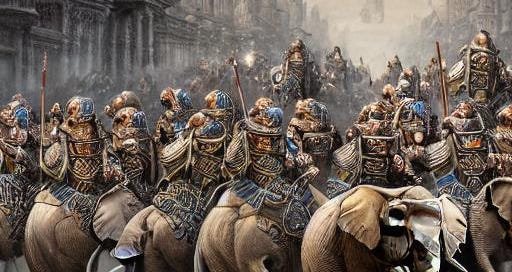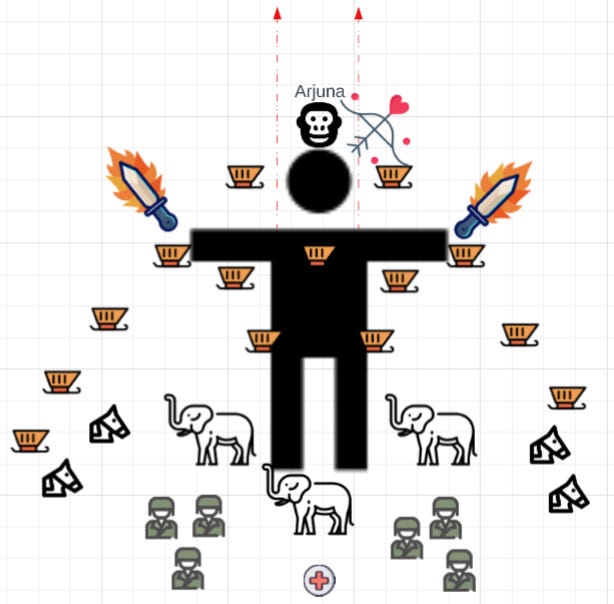The four forces are tuskers, chariots, cavalry and infantry.
Military units in scale by powers of 3.
The atomic unit is the Patti with 1 elephant.
The next scale is a Senamukha (military unit/mouth), which is composed of 3 Pattis.
Why scale by 3?
Three elephants are the minimal required to maintain a 2-dimensional frame - the triangulated space between three elephants arranged in a ring formation is a unit of territory. With 2 elephants can only create a 1-dimensional space - a line between two nodes. Three elephants led in a circle can claim and maintain a battlefield space.
Figure 1. Contrived depiction of the four forces in formation on the field of battle in (rane).[1]
At scale the formations and movements of the elephants formed Vyuhas. Vyuhas were tactical. Depending on how an opponent arranged their Vyuha a general may arrange one to counter it. The challenge owed to the maneuvering required to keep elephants, horses and men in formation without breaking ranks, or mixing, into chaos.
A champion (Arjuna) may be identified in battle both as the individual Arjuna that fights in the chariot in figure 1 - and 'Arjuna' as the sum of battle formation led by Arjuna against other armies. - depicted as the silhouette stick figure Arjuna behind the arrowhead formation of chariots, elephants, cavalry.
A champion's ornamented arms may literally be his arms or the skilled chariots to his sides that protect his wheels or come forward to attack a flank. His trunk-like legs may be his legs or refer to the tuskers and troops behind him that ballast his movement. A champion's heart may also be troop morale. To ‘pierce’ a foe may mean to penetrate their range with an arrow that is neither repulsed nor short - an indication that one warrior has the advantage of spacing the same way that a boxer who finds there range against another boxer has the upper hand. A champions heart may be shattered by the champion's literal heart being penetrated with a lance or arrow at death - or it could be a decisive blow against their formation that scatters their troops or demonstrates their inferiority. Alambusa is killed twice; once when Gatotkacha defeats his prestige by defeating him, and later when Alambusa is killed as just another minor warrior. When hearts are shattered troops break rank and flee. The discipline of the formation breaks down as the men panic. Then the four forces mix. Hell breaks loose when the forces mix.
Vyuhas are complex arrangements of the military units at scale - (3^7)*10 Pattis are an Akshouhini. There were 18 Akshouhinis in this war. Different arrangements and patterns of movement of elephants create different vyuhas. Some vyuhas, like the legendary Chakravyuha, require great skill through the army to maintain. The Chakravyuha was a formation that created an inescapable maze for a warrior caught in its space.
"Those on your side descended upon Abhimanyu. But the brave one was swift. He used weapons that penetrated the inner organs. He slaughtered them by many different kinds of sharp arrows. They were like helpless insects descending into the fire. Their bodies soon covered the earth. He spread severed limbs around like a priest covering the altar with kusha grass. There were arms with armguards and finger-guards, holding bows and arrows, swords and shields, goads, reins, lances and battleaxes, balls with iron spikes, spears, scimitars, spikes, javelins, catapults, clubs, darts, whips, giant conch shells, spears, hair catchers, maces, slings, nooses, heavy maces and stones. The arms bore armlets and bracelets. They were smeared with unguents. Arjuna's son severed those arms by the thousands. They were strewn around, deprived of cushions. Their tongues lolled. The eyes bulged. Entrails and livers spilled out of their torn bodies. This delighted large numbers of flesh-eaters."
- Abhimanyu-Vadha Parva. Chapter 35
"Without fear, Vasatiya advanced and attacked Abhimanyu. Vasatiya's troops fired sixty gold-tufted arrows at Abhibmanyu's. Abhimanyu pierced Vasatiya in the heart. Losing his life, Vasatiya fell down to the ground. The enemy had Abhimanyu surrounded and trapped. But Abhimanyu was wrathful. He sliced down their arrows and bows and the heads from bodies. Severed arms were seen. They held swords and finger guards, lances and battleaxes. There were armor and shields, necklaces, crowns umbrellas and whisks. It became impassable because of seats and poles and shattered fragmented axles, wheels and yokes in thousands. Flags, chariots, horses and elephants were strewn on the ground."
- Abhimanyu-Vadha Parva. Chapter 43
"Thousands of angry elephant-riders from Anga surrounded Pandava. Those elephants were like mountains and were urged on by Duryodhana. Arjuna swiftly shot arrows from Gandiva and severed the heads and the arms of those who were at the front. Those heads and arms were strewn around on the ground. They were as dazzling as golden stones encircled with snakes. Arms and heads were severed and fell down. They seemed to be like birds falling down from the trees. Thousands of elephants were pierced, and blood began to flow. They were beautiful like mountains streaked with red chalk."
- Jayadratha Vadha Parva. Chapter 68
"Drona, Kripa, Karna, Ashvatthama, Brihadbala, and Kritavarma surrounded Abhimanyu. Abhimanyu pierced Drona with fifty arrows and Prihadbala with twenty. Kritavarma with eighty. Kripa with sixty arrows. Ten forceful arrows pierced Ashvatthama. He pierced Karna in the ear and killed Kripa's horses and the two charioteers who guarded his flanks.[0] He pierced him between the breast with ten arrows. Ashvatthama pierced him back with sixty arrows. Abhimanyu returned seventy-three arrows. Drona's array fired one hundred arrows. Karna fired twenty-two. Brihadbala with fifty. Kripa with ten. Abhimanyu pierced Brihadbala in the heart with a single arrow and brought him down.
- Abhimanyu-Vadha Parva. Chapter 46
"Abhimanyu smiled. He stretched his bow and severed his head with a single arrow, which fell down from the chariot onto the ground. It was beautiful like a tree uprooted from a mountain by the wind. O King!" [1]
- Abhimanyu-Vadha Parva. Chapter 40
The war lasted for 18 days. Abhimanyu was killed on the 13th day. Abhimanyu's death sets up the climactic 14th day. Arjuna has sworn to kill Jayadratha in revenge or enter the fire if he fails. While Arjuna slices through the Kaurava army like a hot knife through butter, Duryodhana rushes Yudhishthira. If the Kauravas can capture the Pandava king before Arjuna and Krishna fight their way to Jayadratha, Arjuna will be forced to make a choice of losing the war by giving up Yudhishthira or break his oath to defend Yudhishthira - thereby securing the Pandavas defeat after Arjuna is gone. The hero of the day is Satyaki - Arjuna's protege - who wins the blistering action who stands as the last man between Yudhishthira and the on-rushing Kauravas horde.
Notes
[1] For more on the formation of vyuhas see
[2] source image Chakravyuha - Wikipedia
[3] Quotes attr. to Debroy, Bibek. The Mahabharata. Penguin Random House India, 2015.








